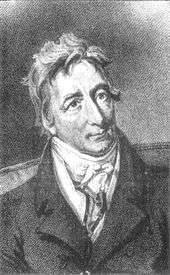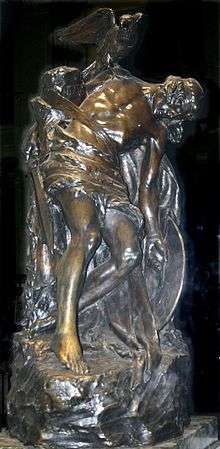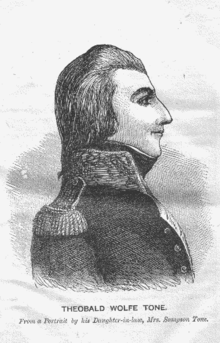Protestant Irish nationalists
Protestant Irish nationalists refers to adherents of Protestantism in Ireland who also support Irish nationalism. Protestants have played a rather large role in the development of Irish nationalism since the eighteenth century, despite most Irish nationalists historically being from the Irish Catholic majority, as well as most Irish Protestants usually tending toward unionism in Ireland. Protestant nationalists (or patriots, particularly before the mid-19th century) have consistently been influential supporters and leaders of various movements for the political independence of Ireland from Great Britain. Historically, these movements ranged from supporting the legislative independence of the Parliament of the Kingdom of Ireland; to a form of home rule within the United Kingdom of Great Britain and Ireland, to complete independence in an Irish Republic, and (since the partition of Ireland) a United Ireland.
Despite their relatively small numbers, individual Protestants have made important contributions to key events in Irish nationalist history, such as Wolfe Tone during the 1798 rebellion, Charles Stewart Parnell and the Home Rule movement, and Robert Erskine Childers and the 1916 Easter Rising.
Today the relationship between Protestants and Irish nationalism differs sharply between Northern Ireland and the Republic of Ireland. In the Republic, the vast majority of Protestants accept and support the independence of Ireland, even if there have been tensions over the central role of the Catholic Church in independent Ireland.[1] The only explicitly unionist political movement of any significance is The Reform Group, a pressure group which advocates that the Republic of Ireland should rejoin the Commonwealth, but does not contest any elections. In Northern Ireland, however, the vast majority of Ulster Protestants are unionist and vote for unionist parties. In 2008, only 4% of Protestants in Northern Ireland thought the long-term policy for Northern Ireland should be unification with the Republic of Ireland, whereas 89% said it should be to remain in the United Kingdom.[2] A poll conducted in 2014 by the Belfast Telegraph shows support for the prospect among Protestants has risen to 12%.
All the various denominations of Protestantism in Ireland have had members involved in nationalism. Historically the Anglican Church of Ireland and the Presbyterian Church of Ireland have been the largest Protestant churches, and this remains the situation across the island of Ireland today. The largest Protestant denomination is the Church of Ireland (having roughly 365,000 members,[3] making up around 3% of the population of the Republic of Ireland and 15% of Northern Ireland) (6.3% of Ireland's population), followed by the Presbyterian Church, with a membership of around 300,000,[4] accounting for 0.6% of people in the Republic and 20% in Northern Ireland (6.1% of Ireland's population).
Pre-Union background

In the eighteenth century the first attempt towards a form of greater Irish home rule under the British Crown was led by the Irish Patriot Party in the 1770s and 1780s, inspired by Henry Grattan.
The Age of Revolution inspired Protestants such as Wolfe Tone, Thomas Russell, Henry Joy McCracken, William Orr, Lord Edward Fitzgerald, the brothers Sheares, Archibald Hamilton Rowan, Valentine Lawless, and others who led the United Irishmen movement. At its first meeting on 14 October 1791, almost all attendees were Presbyterians, apart from Tone and Russell who were both Anglicans. Presbyterians, led by McCracken, James Napper Tandy, and Neilson would later go on to lead Ulster Protestant and Catholic Irish rebels in the Irish Rebellion of 1798. Tone did manage to unite if only for a short time, at least, some Anglicans, Catholics and Dissenters into the "common name of Irishmen", and would later go on to try to get French support for a rising, first manifested in the failed French Bantry Bay landing of 1796.
At that time, the French republicans were opposed to all churches. Such people were inspired by Thomas Paine of the American Revolution, who disapproved of organised religions in The Age of Reason (1794–1795) and preferred a deist belief. Although the United Irish movement was supported by individual priests, the Roman Catholic hierarchy was opposed to it, because of a growing rapprochement between Rome and London (one example of which was the funding of the new seminary in Maynooth by the British government in 1795).
During the 1798 rebellion the military leaders were also largely Anglicans. After the initial battles in County Kildare the rebels holding out in the Bog of Allen were led by William Aylmer. In Antrim and Down the rebels were almost all Presbyterians, and at the Battle of Ballynahinch the local Catholic Defenders decided not to take part. In County Wexford, which remained out of British control for a month, the main planners were Bagenal Harvey and Anthony Perry. Joseph Holt led the rebels in County Wicklow. Only in Mayo, where there were few Protestants, was the rebellion led entirely by Catholics, and it only developed there because of the landing by a French force under General Humbert. The disarming of Ulster saw several hundred Protestants tortured, executed and imprisoned for their United Irish sympathies. The rebellion became the main reason for the Acts of Union, which passed in 1800.
1803 and 1848
In 1803 there was another Irish rebellion led by Robert Emmet, brother of Thomas Addis Emmet. He was joined by other Protestants such as James Hope and was later executed for his part in the rising. In the 1840s Thomas Davis, the revolutionary writer and poet, and John Mitchel were involved in the radical politics of their day, and William Smith O'Brien led the rebellion in 1848.
The democratic and non-violent Repeal Association led by Daniel O'Connell in the 1830s and 1840s was supported by a number of Protestants; the most eminent being Sir John Gray, who later supported Butt and Parnell (see below), and others such as James Haughton.
Home Rule era (1870–1914)
Politicians

The new Home Government Association was founded by Isaac Butt in 1870, who died in 1873. William Shaw presided over the convention held to found its successor, the Home Rule League, of which he was chairman. He was followed by Charles Stewart Parnell, the founder of the Irish Parliamentary Party (IPP). Herbert Henry Asquith called Parnell one of the most important men of the nineteenth century and Lord Haldane called him the most powerful man that the Parliament of the United Kingdom of Great Britain and Ireland had seen in 150 years. Parnell led the Gladstonian constitutionalist Home Rule movement and for a time dominated Irish and British affairs. However, at the height of his power he was to be dethroned by the O'Shea divorce affair and died soon afterwards.
Other Protestant Nationalist members of parliament were: Sir John Gray, Stephen Gwynn, Henry Harrison, Jeremiah Jordan, William McDonald, J. G. Swift MacNeill, James Maguire, Pierce Charles de Lacy O'Mahony, Isaac Nelson, John Pinkerton, Horace Plunkett and Samuel Young.
Several Protestant figures in the early Northern Ireland Labour Party were nationalists. These included MPs Jack Beattie, Sam Kyle and William McMullen and labour leaders James Baird and John Hanna.[5] Meanwhile, trade unionist Victor Halley was a member of the Socialist Republican Party.
Artists

While not active nationalist supporters, authors who wrote about Irish life and history, such as William Wilde, Whitley Stokes, Standish James O'Grady and Samuel Ferguson helped to develop nationalist sentiment.
From 1897 the artist and mystic George Russell (also known as "Æ") helped Horace Plunkett to run the Irish Agricultural Organisation Society.[6] The IAOS rapidly grew into the main Irish rural co-operative body through which Irish farmers could buy and sell goods at the best price. Plunkett was also a cousin of George Noble Plunkett, father of Joseph Mary Plunkett. Horace Plunkett's home in County Dublin was later burned down in 1922 by anti-treaty Irish republicans during the Irish Civil War, as he had been appointed a Senator in the first Irish Free State Senate.
Russell was also involved in the "Irish Literary Revival" (or Celtic Twilight) artistic movement, that provided an intellectual and artistic aspect supportive of Irish nationalism. This was also largely started and run by Protestants such as WB Yeats, Lady Gregory, Seán O'Casey, Alice Milligan, and JM Synge, who also founded the influential but controversial Abbey Theatre that opened in 1904. "An Túr Gloine" (The Glass Tower) had a similar membership.
The archetypal work of art that commemorated the 1916 Rising, though sculpted five years before the rising, is the statue of the dying mythical warrior Cuchullain, sculpted by Oliver Sheppard, a Protestant art lecturer in Dublin who had been a moderate nationalist for decades. Cast in bronze, it was unveiled at the GPO in 1935.
Independence era (1916–22)

Sam Maguire inducted Michael Collins into the Irish Republican Brotherhood (IRB) in 1909. From 1928 the main prize for Irish football awarded by the Gaelic Athletic Association has been the Sam Maguire Cup.
In 1908 Bulmer Hobson and Constance Markievicz founded the Fianna Éireann, intended as a nationalist Boy Scout movement. The Irish Volunteers were a paramilitary organisation established in 1913 by Irish Nationalists and separatists including Roger Casement, Bulmer Hobson and Robert Erskine Childers, all Protestant Irish nationalists (although Casement, who had been secretly baptised a Catholic by his mother, officially converted to Catholicism just before he was hanged in 1916). The Irish Volunteers were formed in response to the formation of the Ulster Volunteers by Edward Carson and James Craig. The Ulster Volunteers were a Unionist paramilitary movement who feared a Dublin-centric, anti-Protestant Home Rule parliament in Dublin.
The Irish Citizen Army existed from 1913–1947 and one of its creators was Jack White from Ulster, son of General George White. On Easter Monday, 24 April 1916, 220 of the group (including 28 women) took part in the Easter Rising. Most of the rifles and ammunition used in the Rising had been imported from Germany in July 1914 by Robert Erskine Childers on his yacht "Asgard" along with Conor O'Brien, Alice Stopford Green, Mary Spring Rice, Darrell Figgis and the former Quaker Bulmer Hobson. The rest of the rifles were shipped by Sir Thomas Myles, at the suggestion of the barrister James Meredith, and were landed at Kilcoole. In 1913 Hobson had sworn Patrick Pearse into the IRB; Pearse was one of leaders of the Rising. A prominent signatory to the Anglo-Irish Treaty in late 1921 that followed the Anglo-Irish war was Robert Barton, a cousin of Childers. A cousin of both, David Lubbock Robinson, was in the IRA and interned. He later became a Fianna Fáil Senator.[7]
In the subsequent Irish Free State governments Ernest Blythe, a former member of the Irish Volunteers, held various ministerial posts. Seán Lester was a League of Nations diplomat. The founder of the Gaelic League and first President of Ireland was Douglas Hyde. Dorothy Macardle opposed the 1921 Treaty and was a lifelong supporter of Éamon de Valera, writing his view of history in The Irish Republic (1937), but also refusing his suggestion to convert to Catholicism on her deathbed in 1958. Some like the Revd. Robert Hilliard fought in the Spanish Civil War in 1936–39.
Following independence, southern Protestant unionists accepted the new reality and worked with the new Free State from its difficult start in 1922–23. These included judges such as Lord Glenavy, whose suggestions for a new law courts system was enacted as the Courts Act 1924, and twenty accepted nominations to the new Senate, such as Lord Mayo.
Protestant nationalist converts to Roman Catholicism
A number of Protestant nationalists also converted to Catholicism, for a variety of reasons:
- William Gibson, 2nd Baron Ashbourne
- Ada Beesley, the second wife of John Redmond
- Thomas Bennett
- Charles Bewley
- Joseph Biggar MP
- Aodh de Blácam (né Hugh Blackham)[8]
- Hon. Albinia Broderick (Gobnait Ní Bhruadair, sister of the Southern Unionist leader Lord Midleton)
- Roger Casement
- Oscar Wilde
- Lillie Connolly, widow of James Connolly[9]
- Charlotte Despard, sister of Viscount French (Lord Lieutenant of Ireland 1918–21)
- Hugh Law MP and TD
- Mary Hutton (author of The Tain, 1907)
- Sir Shane Leslie
- Grace Gifford, sister of Muriel, wife of Joseph Plunkett
- Muriel Gifford, sister of Grace, wife of Thomas MacDonagh
- Maud Gonne
- Mabel McConnell, wife of Desmond FitzGerald and mother of Garret FitzGerald
- Countess Markievicz MP and TD
- Pierce Charles de Lacy O'Mahony MP
- Gertrude Parry (cousin of Roger Casement)
- Herbert Moore Pim (who returned to unionism in 1918)
- William Stockley
- Francis Stuart
- Edmund Dwyer Gray, son of Protestant nationalist, Sir John Gray
1940–present
John Graham, George Gilmore and George Plant, were amongst a handful of Protestants who joined the minority Republican Congress and the Irish Republican Army in the 1930s and 1940s.[5] Plant was executed in 1942 by the Irish government for the murder of a suspected informer.[10]
Later figures included Ronnie Bunting of the Irish National Liberation Army and John Turnley who were assassinated by the Ulster Defence Association. Bunting was the son of Ronald Bunting, a close associate of Ian Paisley.[11] John Turnley, also killed in 1980, was the Protestant Chairman of the Irish Independence Party and an Anti H-Block campaigner. David Russell was a Protestant Provisional IRA volunteer originally from Ramelton in Donegal and a Presbyterian. He was killed due to a premature bomb explosion in 1974 at a supermarket in Derry.[12]
Since partition, the majority of Ulster Protestants oppose the unification of Ireland, traditionally supporting continued union with Great Britain. In the past, the Social Democratic and Labour Party (SDLP) has had Protestant representatives, the most famous being Ivan Cooper. Billy Leonard, a former lay-preacher and Royal Ulster Constabulary (RUC) reservist, was an MLA for Sinn Féin in Stormont.
Republic of Ireland
Martin Mansergh, a member of the Church of Ireland, has been influential in formulating Fianna Fáil's policy on Northern Ireland since the peace process began in the 1990s.
See also
Sources
- O'Broin, Leon; Protestant Nationalists in Revolutionary Ireland, Barnes & Noble 1985, ISBN 978-0-389-20569-2
References
- ↑ Ruane, Joseph: Southern Irish Protestants:an example of de-ethnicisation?, University College Cork
- ↑ "Northern Ireland Life and Times Survey 2008". Ark.ac.uk. 4 June 2009. Retrieved 9 January 2010.
- ↑ "World Council of Churches". Oikoumene.org. Retrieved 9 January 2010.
- ↑ "Presbyterian Church of Ireland". Presbyterianireland.org. Retrieved 9 January 2010.
- 1 2 Michael Farrell, Northern Ireland: The Orange State
- ↑
- ↑ http://www.oireachtas.ie/members-hist/default.asp?MemberFirstName=david+&MemberName=robinson&disp=src&housetype=&HouseNum=&ConstID=
- ↑ "Aodh de Blacam notes". Ricorso. 15 September 1991. Retrieved 9 January 2010.
- ↑ Gone But Not Forgotten – Fiona Connolly
- ↑ Moroney, Michael (1988). "George Plant & The Rule of Law: The Devereux Affair (1940–42)". Tipperary Historical Journal: 1–12. Retrieved 13 March 2012.
- ↑ "Beginning of the End". Irishdemocrat.co.uk. Retrieved 9 January 2010.
- ↑ http://cain.ulst.ac.uk/sutton/chron/1974.html
